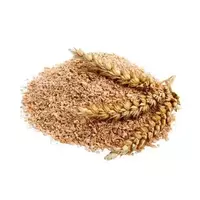Wheat bran

Wheat bran is a byproduct of the milling industry, although the world's nutritionists recognize its healing properties. In fact, this product is the fruit shells of grains, which are removed by producers during the processing of grain crops. This makes cleaned (refined) products tasty and outwardly more attractive, but their valuable nutritional qualities are lost.
Regarding the culinary application of wheat bran, we can say that there are so many dishes with this product and they are so tasty that it is quite difficult to decide on the choice. But in general, ready-made meals with wheat bran in the composition are very simple and available to everyone.
As a rule, bran is usually added to dough, cocktails, jelly, porridge, soups, fish and meat and minced meat, salads. In addition, they are often used as breading. Even the simple, but very useful buckwheat porridge with onions and wheat bran turns out to be unusually tasty.
Composition of wheat bran
The composition of wheat bran contains everything useful that nature has created: in particular, the grain embryo, the flower shell of wheat, as well as the aleuron layer of the endosperm. In other words, more than 90 percent of all useful that is present in wheat grains is concentrated directly in these parts.
Wheat bran and vitamins are rich. And wheat bran also includes mineral salts - iron, phosphorus, sodium, magnesium, calcium and potassium. The calorie content of wheat bran is on average about 165 kcal.
Benefits of wheat bran
The benefits of wheat bran for the human body are due to the high content of fiber, which, once in food, retains a large amount of water. Moving further, in the intestine and colon, it has a cleansing effect. That is why the beneficial properties of wheat bran are so relevant for constipation.
It has been proven that regular consumption of wheat bran contributes to the normalization of cardiovascular activity, which is due to the special property of this product to reduce cholesterol, thereby creating a barrier for the formation of atherosclerotic plaques in the vessels.
Due to the obvious benefits of wheat bran for the heart and blood vessels, experts advise you to include this product in the diet as often as possible. Thus, such serious ailments as arrhythmia, atherosclerosis, tachycardia, coronary circulation disorders, myocardial infarction and stroke can be avoided.
Damage to wheat bran
However, wheat bran can cause significant harm to the human body in the presence of stomach and duodenal ulcers, ulcerative colitis and adhesion disease of the abdominal cavity. In addition, wheat bran should be used with extreme caution in case of exacerbations of cholecystitis, chronic gastritis, pancreatitis, as well as gastroduodenitis.
wheat bran 216 kCal
Energy value of wheat bran (Ratio of proteins, fats, carbohydrates - ju):
Squirrels: 15.55 (~ 62 kCal)
Fats: 4.25 g. (~ 38 kCal)
Carbohydrates: 64.51 g (~ 258 kCal)
Energy ratio (b | y): 29% | 18% | 119%
 Español
Español Français
Français Português
Português Русский
Русский 简体中文
简体中文 繁體中文
繁體中文 日本語
日本語 한국어
한국어 العربية
العربية Türkçe
Türkçe Қазақ
Қазақ Deutsch
Deutsch Italiano
Italiano Українська
Українська
